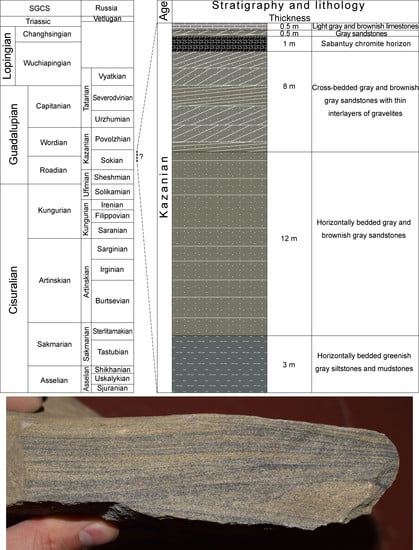Chromite Paleoplacer in the Permian Sediments at the East Edge of the East European Platform: Composition and Potential Sources
Abstract
1. Introduction

2. Sabantuy Placer Locality and Geological Settings
3. Analytical Methods
4. Results
4.1. Lithology and Petrography
4.2. Chemical Composition of Sandstones
4.3. Morphology of Chromspinel Grains
4.4. Composition of Chromspinel
4.5. Inclusions in Chromspinels
5. Discussion
5.1. Potential Sources of Deposits
5.2. Potential Sources for Chromspinels
6. Conclusions
Supplementary Materials
Author Contributions
Funding
Data Availability Statement
Acknowledgments
Conflicts of Interest
References
- Irvine, T.N. Chromium spinel as a petrogenetic indicator. Part, I. Theory. Can. J. Earth Sci. 1965, 2, 648–672. [Google Scholar] [CrossRef]
- Irvine, T.N. Chromium spinel as a petrogenetic indicator. Part II. Petrological applications. Can. J. Earth Sci. 1967, 4, 71–103. [Google Scholar] [CrossRef]
- Dick, H.J.B.; Bullen, T. Chromian spinel as a petrogenetic indicator in abyssal and alpine-type peridotites and spatially associated lavas. Contrib. Mineral. Petrol. 1984, 86, 54–76. [Google Scholar] [CrossRef]
- Arai, S. Characterization of spinel peridotites by olivine-spinel compositional relationships: Review and interpretation. Chem. Geol. 1994, 113, 191–204. [Google Scholar] [CrossRef]
- Sack, R.O.; Ghiorso, M.S. Chromite as a petrogenetic indicator. In Oxide Minerals: Petrologic and Magnetic Significance; Lindsley, D.H., Ed.; Mineralogical Society of America: Chantilly, VA, USA, 1991; Volume 25, pp. 323–353. [Google Scholar]
- Maslov, A.V.; Mizens, G.A.; Badida, L.V.; Krupenin, M.T.; Vovna, G.M.; Kiselev, V.I.; Ronkin, Y.L. Lithogeochemistry of Terrigenous Associations of the Southern Depressions of the Ural Foredeep; IGG UB RAS: Yekaterinburg, Russia, 2015; p. 308. (In Russian) [Google Scholar]
- Mizens, G.A.; Maslov, A.V. Sandstones from the molasse formation in the southern part of the Uralian foredeep. Lithol. Miner. Resour. 2015, 50, 407–431. [Google Scholar] [CrossRef]
- Gujar, A.R.; Ambre, N.V.; Iyer, S.D.; Mislankar, P.G.; Loveson, V.J. Placer chromite along south Maharashtra, central west coast of India. Curr. Sci. 2010, 99, 492–499. [Google Scholar]
- Pober, E.; Faupl, P. The chemistry of detrital spinels and its implications for the geodynamic evolution of the eastern Alps. Geologische Rundschau 1988, 77, 641–670. [Google Scholar] [CrossRef]
- Emory-Moore, M.; Scott, W.J.; Davis, L. Detrital chromite concentrations, nearshore Port au Port Bay, Newfoundland. Atl. Geol. 1992, 28, 233–241. [Google Scholar]
- Hisada, K.; Arai, S. Detrital chrome spinels in the cretaceous sanchu sandstone, central Japan: Indicator of serpentinite protrusion into a fore-arc region. Palaeogeogr. Palaeoclim. Palaeoecol. 1993, 105, 95–109. [Google Scholar] [CrossRef]
- Hisada, K.I.; Arai, S.; Lee, Y.I. Tectonic implication of lower cretaceous chromian spinel-bearing sandstones in Japan and Korea. Isl. Arc 1999, 8, 336–348. [Google Scholar] [CrossRef]
- Lenaz, D.; Kamenetsky, V.S.; Crowford, A.J.; Princivalle, F. Melt inclusions in detrital spinel from the SE Alps (Italy–Slovenia): A new approach to provenance studies of sedimentary basins. Contrib. Mineral. Petrol. 2000, 139, 748–758. [Google Scholar] [CrossRef]
- Oberhänsli, R.; Wendt, A.S.; Goffé, B.; Michard, A. Detrital chromites in metasediments of the east-Arabian continental margin in the Saih Hatat area: Constraints for the palaeogeographic setting of the Hawasina and Semail basins (Oman mountains). Int. J. Earth Sci. 1999, 88, 13–25. [Google Scholar] [CrossRef]
- Zhu, B.; Kidd, W.S.F.; Rowley, D.B.; Currie, B.S. Chemical compositions and tectonic significance of chrome-rich spinels in the Tianba Flysch, southern Tibet. J. Geol. 2004, 112, 417–434. [Google Scholar] [CrossRef]
- Faupl, P.; Pavlopoulos, A.; Klötzli, U.; Petrakakis, K. On the provenance of mid-cretaceous turbidites of the Pindos zone (Greece): Implications from heavy mineral distribution, detrital zircon ages and chrome spinel chemistry. Geol. Mag. 2006, 143, 329–342. [Google Scholar] [CrossRef]
- Pownceby, M.; Bourne, P. Detrital chrome-spinel grains in heavy-mineral sand deposits from southeast Africa. Mineral. Mag. 2006, 70, 51–64. [Google Scholar] [CrossRef]
- Al-Juboury, A.I.; Ghazal, M.M.; Mccann, T. Detrital chromian spinels from miocene and holocene sediments of northern Iraq: Provenance implications. J. Geosci. 2009, 54, 289–300. [Google Scholar] [CrossRef][Green Version]
- Pirnia, T.; Arai, S.; Torabi, G. A Better picture of the mantle section of the Nain ophiolite inferred from detrital chromian spinels. J. Geol. 2013, 121, 645–661. [Google Scholar] [CrossRef]
- Baxter, A.T.; Aitchison, J.C.; Ali, J.R.; Chan, J.S.-L.; Chan, G.H.N. Detrital chrome spinel evidence for a neotethyan intra-oceanic island arc collision with India in the paleocene. J. Asian Earth Sci. 2016, 128, 90–104. [Google Scholar] [CrossRef]
- Bónová, K.; Mikuš, T.; Bóna, J. Is Cr-spinel geochemistry enough for solving the provenance dilemma? Case study from the Palaeogene sandstones of the western Carpathians (eastern Slovakia). Minerals 2018, 8, 543. [Google Scholar] [CrossRef]
- Puchkov, V.N. Paleogeodynamics of the Southern and Middle Urals; Gilem: Ufa, Russia, 2000; p. 146. (In Russian) [Google Scholar]
- Brown, D.; Herrington, R.J.; Alvarez-Marron, J. Processes of arc–continent collision in the uralides. In Arc-Continent Collision Frontiers in Earth Sciences; Brown, D., Ryan, P.D., Eds.; Springer: Berlin/Heidelberg, Germany, 2011; pp. 311–340. [Google Scholar]
- Puchkov, V.N. Structural stages and evolution of the Urals. Mineral. Petrol. 2013, 107, 3–37. [Google Scholar] [CrossRef]
- Abdulmazitov, H.D.; Baymukhametov, K.S.; Victorin, V.D. Geology and Development of the Largest and Unique Oil and Gas-Oil Fields in Russia, 2nd ed.; Gavura, V.E., Ed.; VNIIOENG: Moscow, Russia, 1996; Volume 1, p. 280. (In Russian) [Google Scholar]
- Kudryashov, A.I. Verkhnekamskoe Salt Deposit; MI UB RAS: Perm, Russia, 2001; p. 429. (In Russian) [Google Scholar]
- Volkov, A.V.; Novikov, I.A.; Razumovsky, A.A.; Murashov, K.Y.; Sidorova, N.V. Geochemical features and formation conditions of the cupriferous sandstones of the Orenburg pre-Urals. Lithosphere 2018, 4, 593–606. (In Russian) [Google Scholar] [CrossRef]
- Alekseev, A.A.; Alekseeva, G.V.; Kovalev, S.G. Layered Intrusions of the Western Slope of the Urals; Gilem: Ufa, Russia, 2000; p. 188. (In Russian) [Google Scholar]
- Savelieva, G.N. Gabbro-Ultrabasite Assemblages of the Urals Ophiolites and Their Analogues in Modern Oceanic Crust; Transactions of the Geological Institute, Academy of Science 404; Nauka: Moscow, Russia, 1987; p. 242. (In Russian) [Google Scholar]
- Savelieva, G.N.; Nesbitt, R.Q. A Synthesis of the stratigraphic and tectonic setting of the Uralian ophiolites. J. Geol. Soc. 1996, 153, 525–537. [Google Scholar] [CrossRef]
- Savelieva, G.N.; Sharaskin, A.Y.; Saveliev, A.A.; Spadea, P.; Pertsev, A.N.; Babarina, I.I. Ophiolites and zoned mafic-ultramafic massifs of the Urals: A comparative analysis and some tectonic implications. In Mountain building in the Uralides: Pangea to Present; Brown, D., Juhlin, C., Puchkov, V., Eds.; AGU Monograph: Washington, DC, USA, 2002; pp. 135–153. [Google Scholar]
- Krause, J.; Brügmann, G.E.; Pushkarev, E.V. Accessory and rock forming minerals monitoring the evolution of zoned mafic-ultramafic complexes in the central Ural mountains. Lithos 2007, 95, 19–42. [Google Scholar] [CrossRef]
- Krause, J.; Brügmann, G.E.; Pushkarev, E.V. Chemical composition of spinel from Uralian-Alaskan-type mafic–ultramafic complexes and its petrogenetic significance. Contrib. Mineral. Petrol. 2011, 161, 255–273. [Google Scholar] [CrossRef]
- Garuti, G.; Pushkarev, E.V.; Thalhammer, O.A.R.; Zaccarini, F. Chromitites of the Urals (part 1): Overview of chromite mineral chemistry and geotectonic setting. Ofioliti 2012, 37, 27–53. [Google Scholar]
- Perevozchikov, B.V. (Ed.) The Registry of Chromite Deposits in Alpine-Type Ultramafites of the Urals; KamaRICSDI: Perm, Russia, 2000; p. 474. (In Russian) [Google Scholar]
- Patyk-Kara, N.G.; Zubkov, L.B.; Bykhovsky, L.Z.; Ryzhov, B.V.; Benevolsky, B.I. Placer Deposits of Russia and Other Countries of Union of Independent States; Scientific World: Moscow, Russia, 1995; p. 454. [Google Scholar]
- Rakhimov, I.R.; Saveliev, D.E.; Kholodnov, V.V.; Zamyatin, D.A. The unique sabantuy chromite paleoplacer in the sedimentary cover of the eastern European platform. Geol. Ore Depos. 2020, 62, 542–546. [Google Scholar] [CrossRef]
- Knyazev, Y.G.; Knyazeva, O.Y.; Snachev, V.I.; Zhdanov, A.V.; Karimov, T.R.; Aydarov, E.M.; Masagutov, R.K.; Arslanova, E.R. State Geological Map of the Russian Federation, 3rd ed.; Scale 1:1,000,000; Ural series. N-40-Ufa; Explanatory Letter; VSEGEI: St. Petersburg, Russia, 2013; p. 512. (In Russian) [Google Scholar]
- Lucas, S.G.; Shen, S.-Z. The Permian chronostratigraphic scale: History, status and prospectus. In The Permian Timescale; Special Publications; Lucas, S.G., Shen, S.Z., Eds.; Geological Society: London, UK, 2018; Volume 450, pp. 21–50. [Google Scholar]
- Russell, R.D.; Taylor, R.E. Roundness and shape of Mississippi river sands. J. Geol. 1937, 45, 225–267. [Google Scholar] [CrossRef]
- Pettijohn, F.J.; Potter, P.E.; Siever, R. Sand and Sandstone, 2nd ed.; Springer: New York, NY, USA, 1987; p. 560. [Google Scholar]
- Barnes, S.J.; Roeder, P.I. The range of spinel compositions in terrestrial mafic and ultramafic rocks. J. Petrol. 2001, 42, 2279–2302. [Google Scholar] [CrossRef]
- Ishii, T.; Robinson, P.T.; Maekawa, H.; Fiske, M. Petrological studies from diapiric serpentine seamounts in the Izu–Ogazawara–Mariana forearc. In Proceedings of the Ocean Drilling Program; Scientific Results; Fryer, P., Pearce, J.A., Stokking, L.B., Eds.; Texas A&M University: College Station, TX, USA, 1992; Volume 125, pp. 445–485. [Google Scholar]
- Evans, B.W.; Frost, B.R. Chrome-spine1 in progressive metamorphism: A preliminary analysis. Geochim. Cosmochim. Acta 1975, 39, 959–972. [Google Scholar] [CrossRef]
- Kamenetsky, V.S.; Crawford, A.J.; Meffre, S. Factors controlling chemistry of magmatic spinel: An empirical study of associated olivine, Cr-spinel and melt inclusions from primitive rocks. J. Petrol. 2001, 42, 655–671. [Google Scholar] [CrossRef]
- Saveliev, D.E. Chromitites of the kraka ophiolite (south Urals, Russia): Geological, mineralogical and structural features. Miner. Depos. 2021. [Google Scholar] [CrossRef]
- Lehmann, J. Diffusion between olivine and spinel: Application to geothermometry. Earth Planet. Sci. Lett. 1983, 64, 123–138. [Google Scholar] [CrossRef]
- Arai, S. Chemistry of chromian spinel in volcanic rocks as a potential guide to magma chemistry. Miner. Mag. 1992, 56, 173–184. [Google Scholar] [CrossRef]
- Gilbert, M.C.; Helz, R.T.; Popp, R.K.; Spear, F.S. Experimental studies of amphibole stability. In Amphiboles: Petrology and Experimental Phase Relations; Veblen, D.R., Ribbe, P.H., Eds.; De Gruyter: Berlin, Germany, 1982; Volume 9, pp. 229–253. [Google Scholar]
- Mizens, G.A. Upper Paleozoic Flysch of the Western Urals; Ural Branch of the Russian Academy of Sciences: Ekaterinburg, Russia, 1997; p. 230. (In Russian) [Google Scholar]
- Afanasyev, V.P.; Pokhilenko, N.P.; Logvinova, A.M.; Zinchuk, N.N.; Efimova, E.S.; Krasavchikov, V.O.; Podgornykh, N.M.; Prugov, V.P. New morphogenetic type of Cr-spinellide in diamondiferous areas in connection with the problem of false kimberlite indicators. Rus. Geol. Geophys. 2000, 41, 1729–1741. (In Russian) [Google Scholar]
- Bhatta, K.; Ghosh, B. Chromian spinel-rich black sands from eastern shoreline of Andaman island, India: Implication for source characteristics. J. Earth Syst. Sci. 2014, 123, 1387–1397. [Google Scholar] [CrossRef]
- Berzin, S.V. Ophiolites of the Mariinsky complex at east and west frames of the Revdinsky Massif. Lithosphere 2016, 1, 88–106. (In Russian) [Google Scholar]
- Kosarev, A.M.; Svetov, S.A.; Chazhengina, S.Y.; Shafigullina, G.T. Boninitic variolites of the Buribay volcanic complex in the southern Urals: Mineralogy, geochemistry and formation conditions. Lithosphere 2018, 18, 246–279. (In Russian) [Google Scholar] [CrossRef][Green Version]
- Pushkarev, E.V.; Ryazantsev, A.V.; Gottman, I.A. Ankaramites of the Prisakmar-Voznesenska zone in the southern Urals—Geological settings and composition. In Year-Book-2016; Institute of Geology and Geochemistry UB RAS: Yekaterinburg, Russia, 2017; Volume 164, pp. 166–175. (In Russian) [Google Scholar]
- Pushkarev, E.V.; Ryazantsev, A.V.; Gottman, I.A.; Degtyarev, K.E.; Kamenetsky, V.S. Ankaramite: A new type of high-magnesium and high-calcium primitive melt in the Magnitogorsk island-arc zone (southern Urals). Doklady Earth Sci. 2018, 479, 463–467. [Google Scholar] [CrossRef]
- Shilo, N.A. Teaching on Placer Deposits; Dalnauka: Vladivostok, Russia, 2002; p. 576. ISBN 5-8044-0200-5. (In Russian) [Google Scholar]
- Roeder, P.l.; Poustovetov, A.; Oskarsson, N. Growth forms and composition of chromian spinel in MORB magma: Diffusion-controlled crystallization of chromian spinel. Can. Mineral. 2001, 39, 397–416. [Google Scholar] [CrossRef]
- Sack, R.O.; Ghiorso, M.S. Chromian spinels as petrogenetic indicators: Thermodynamics and petrological applications. Am. Miner. 1991, 76, 827–847. [Google Scholar]
- Paneyakh, N.A. Evolutuion of the spinel compositions in ultramafites. Miner. J. 1984, 6, 38–52. [Google Scholar]
- Chaschukhin, I.S.; Votyakov, S.L.; Shapova, Y.V. Crystallochemistry of Chromspinel and Oxythermobarometry of Ultramafites of Folded Belts; Koroteev, V.A., Ed.; Institute of Geology and Geochemistry Ural Branch RAS: Yekaterinburg, Russia, 2007; p. 310. (In Russian) [Google Scholar]
- Ghosh, B.; Morishita, T.; Bhatta, K. Significance of chromian spinels from the mantle sequence of the andaman ophiolite, India: Paleogeodynamic implications. Lithos 2013, 164, 86–96. [Google Scholar] [CrossRef]


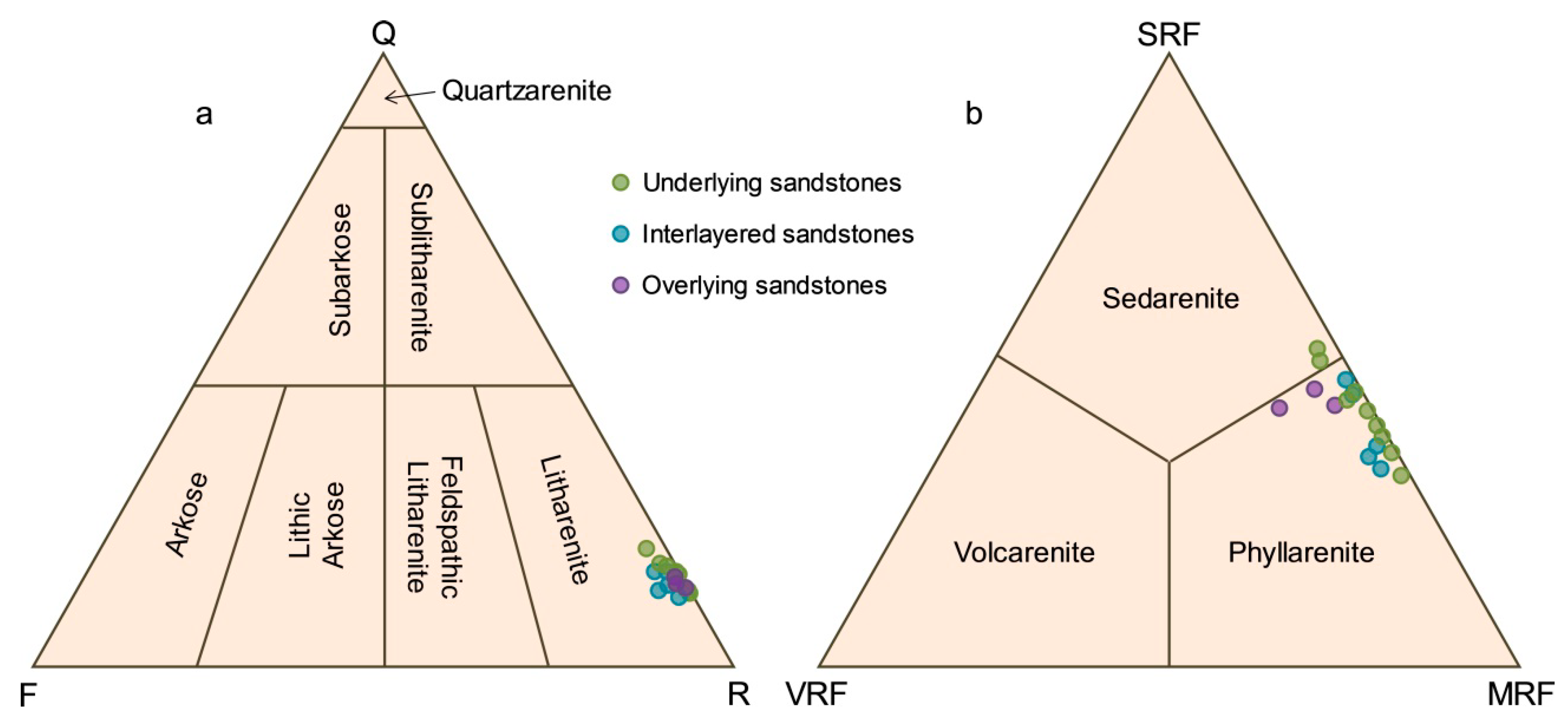
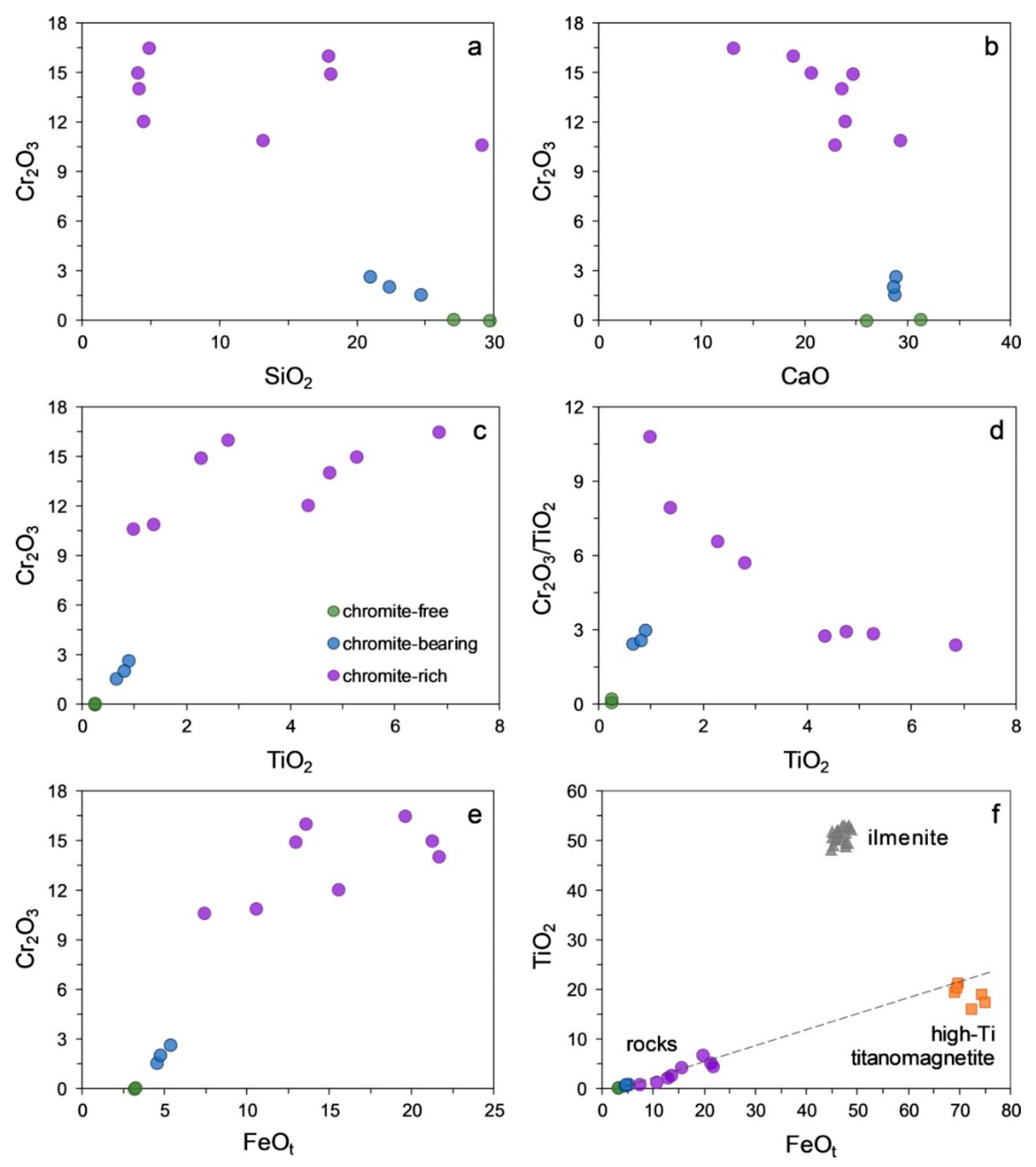


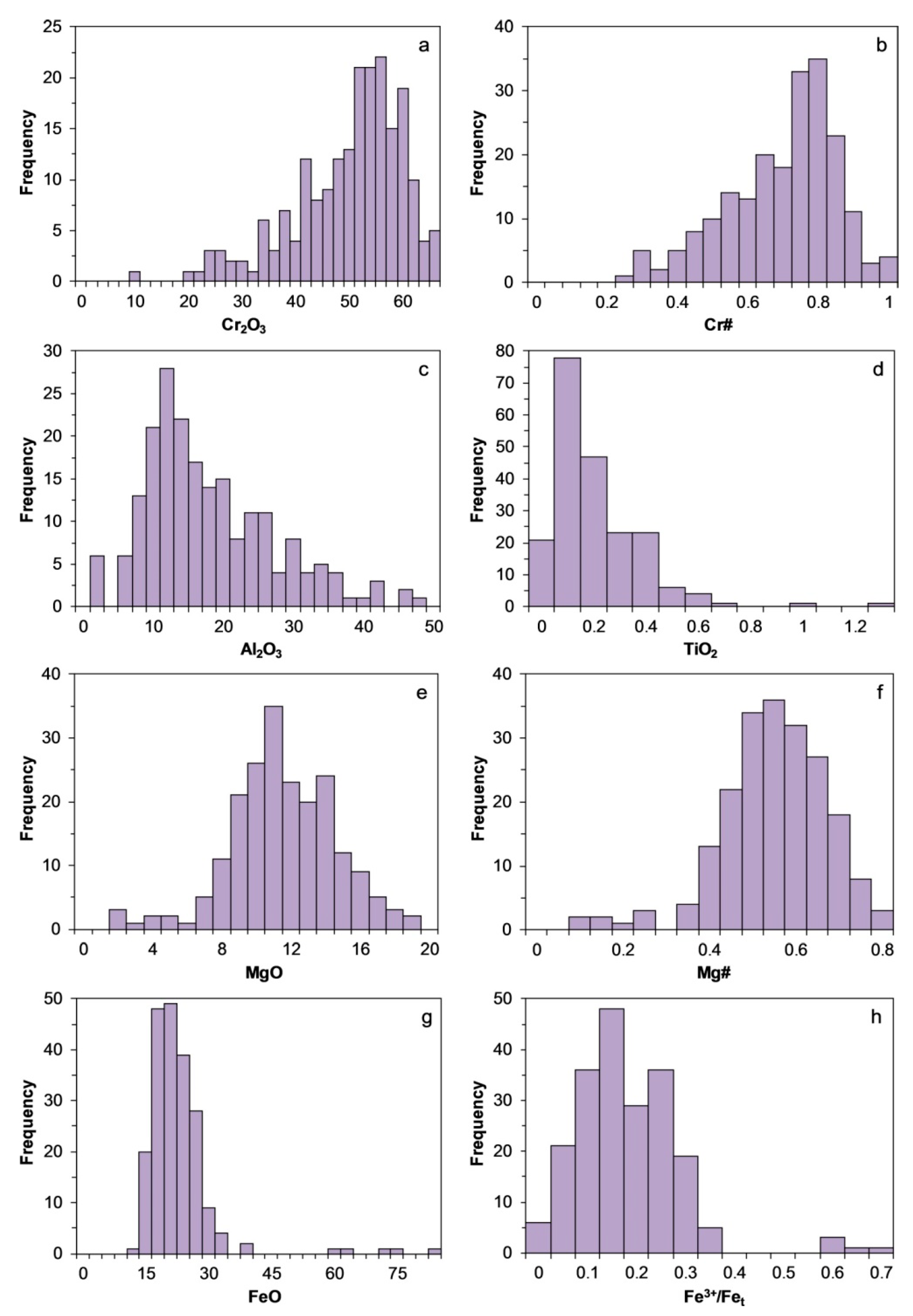
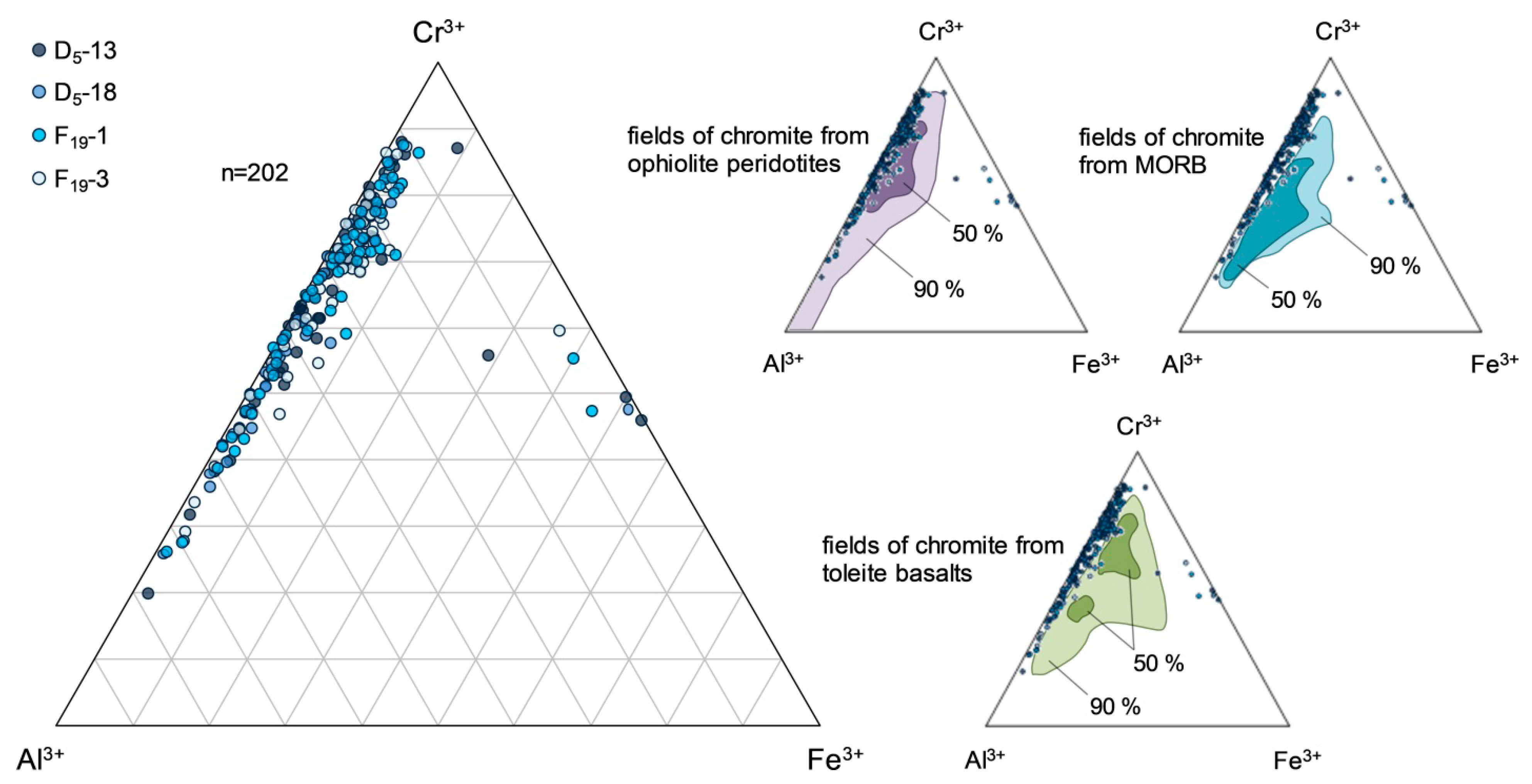
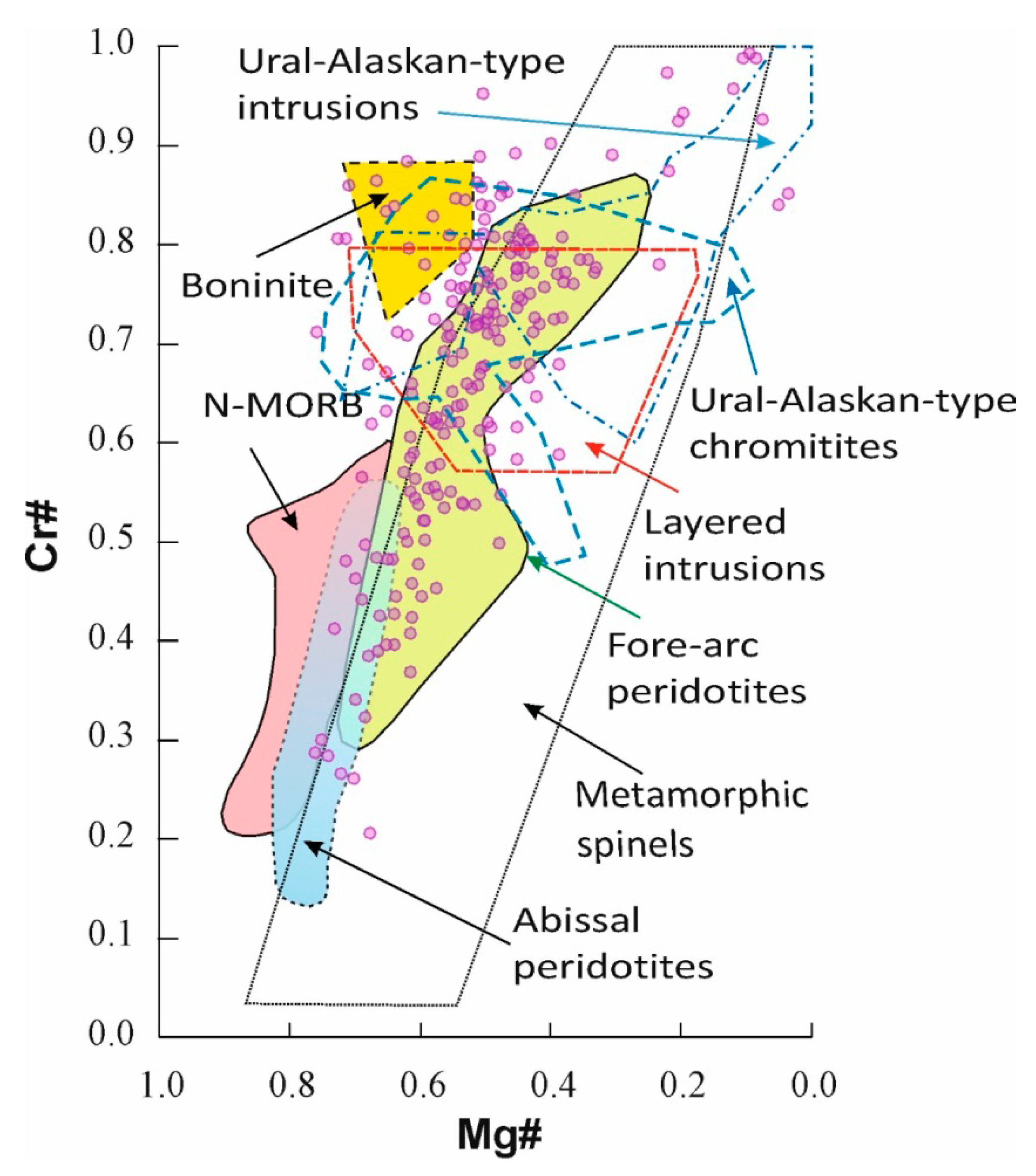
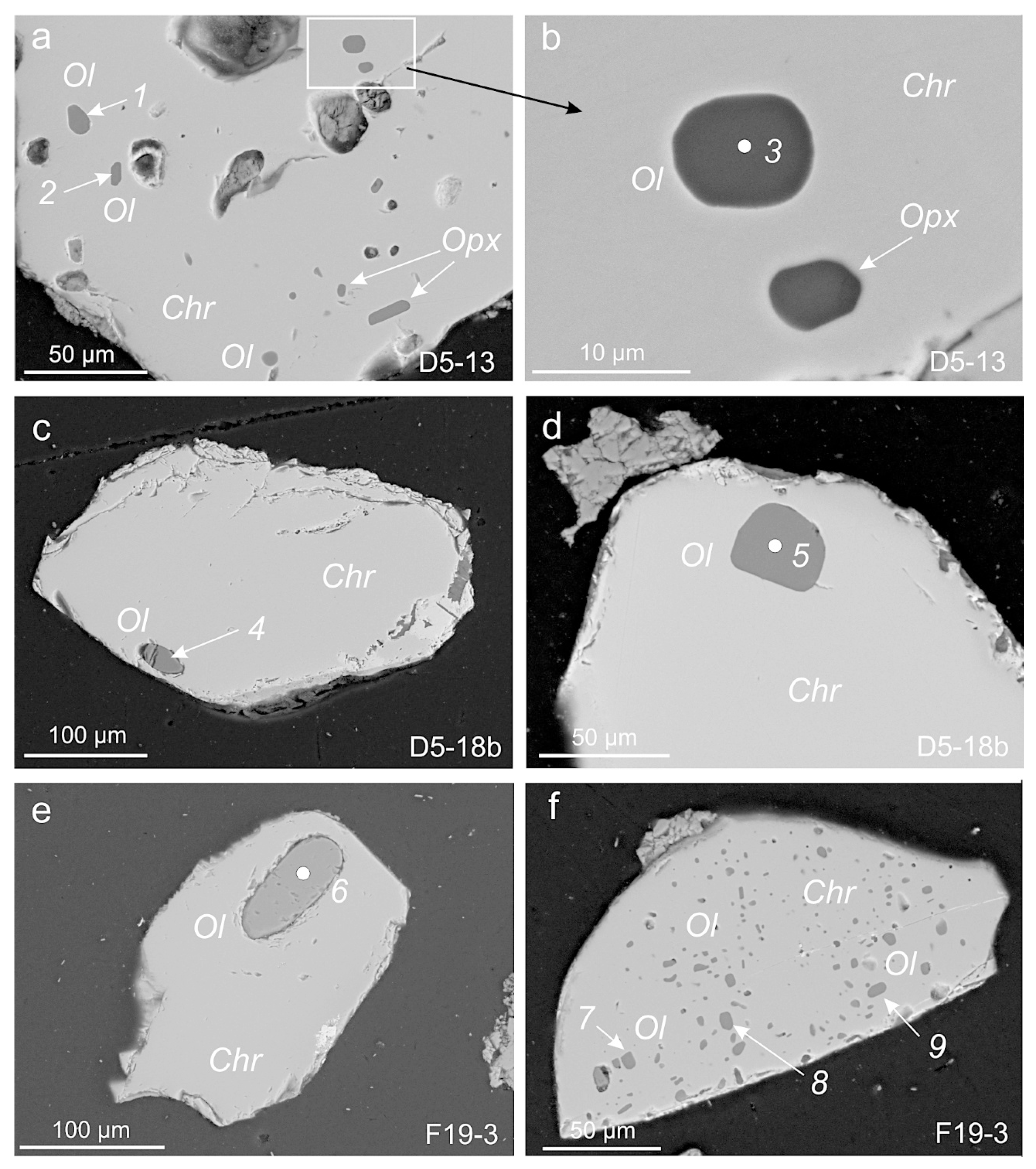
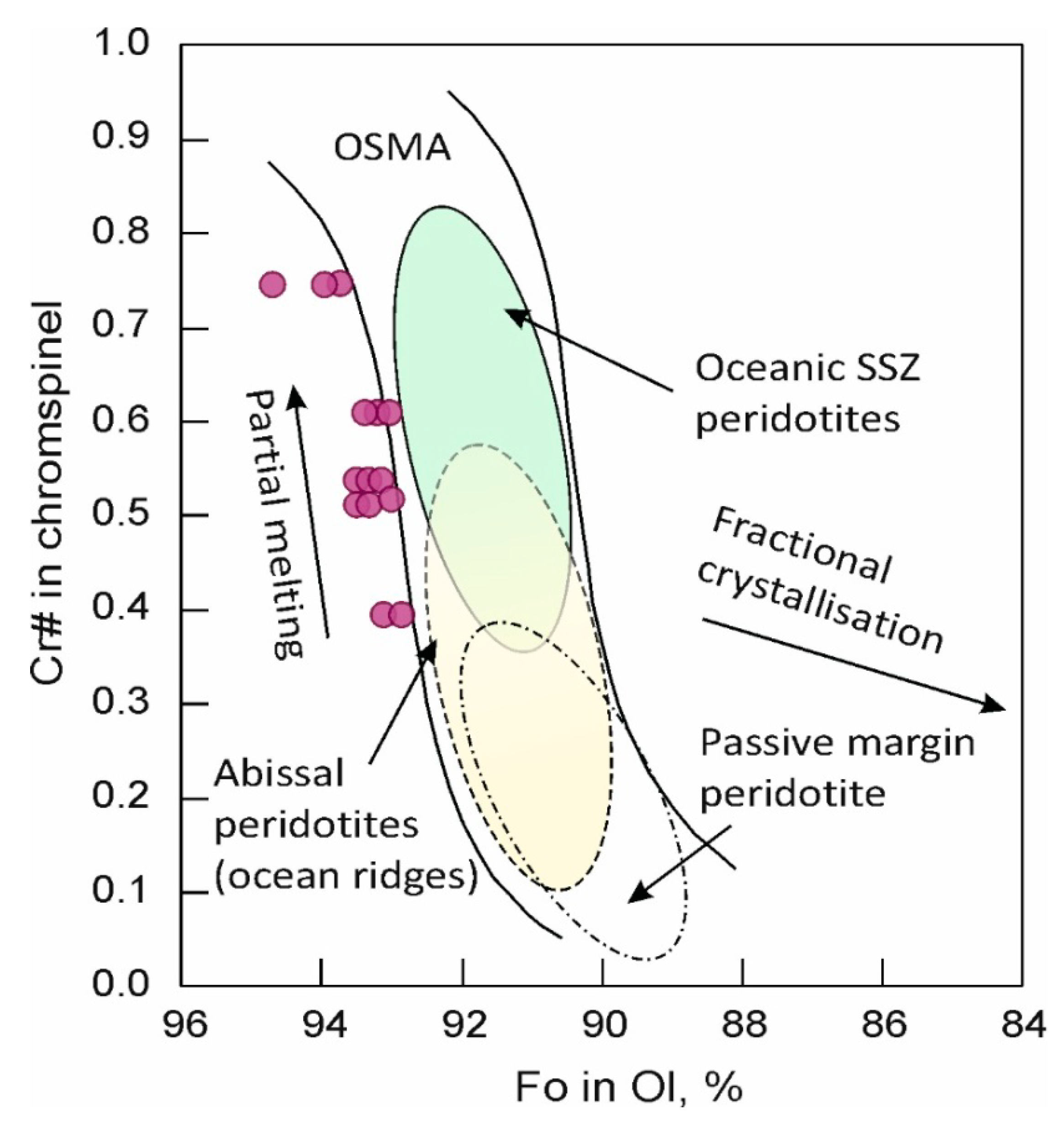

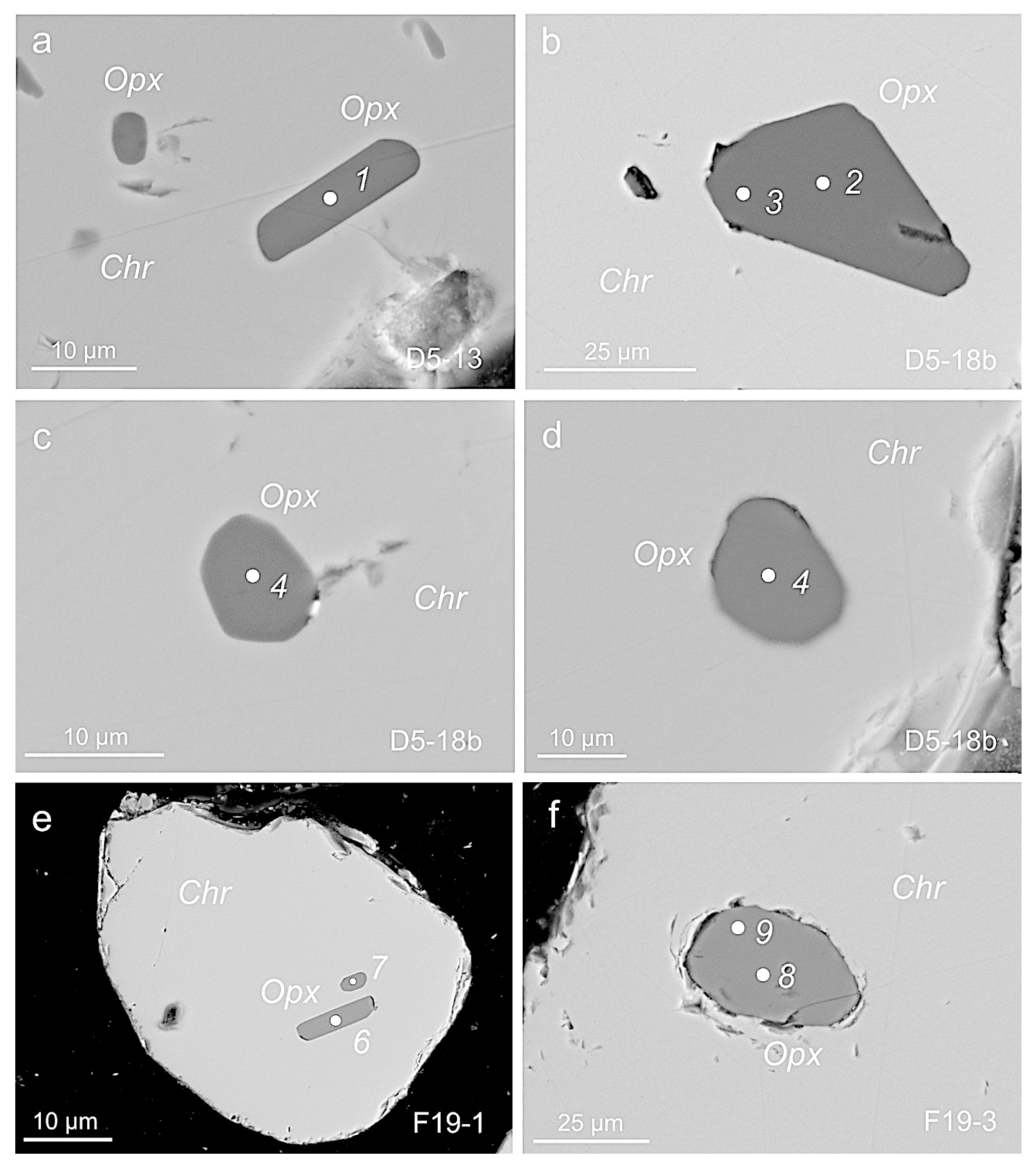
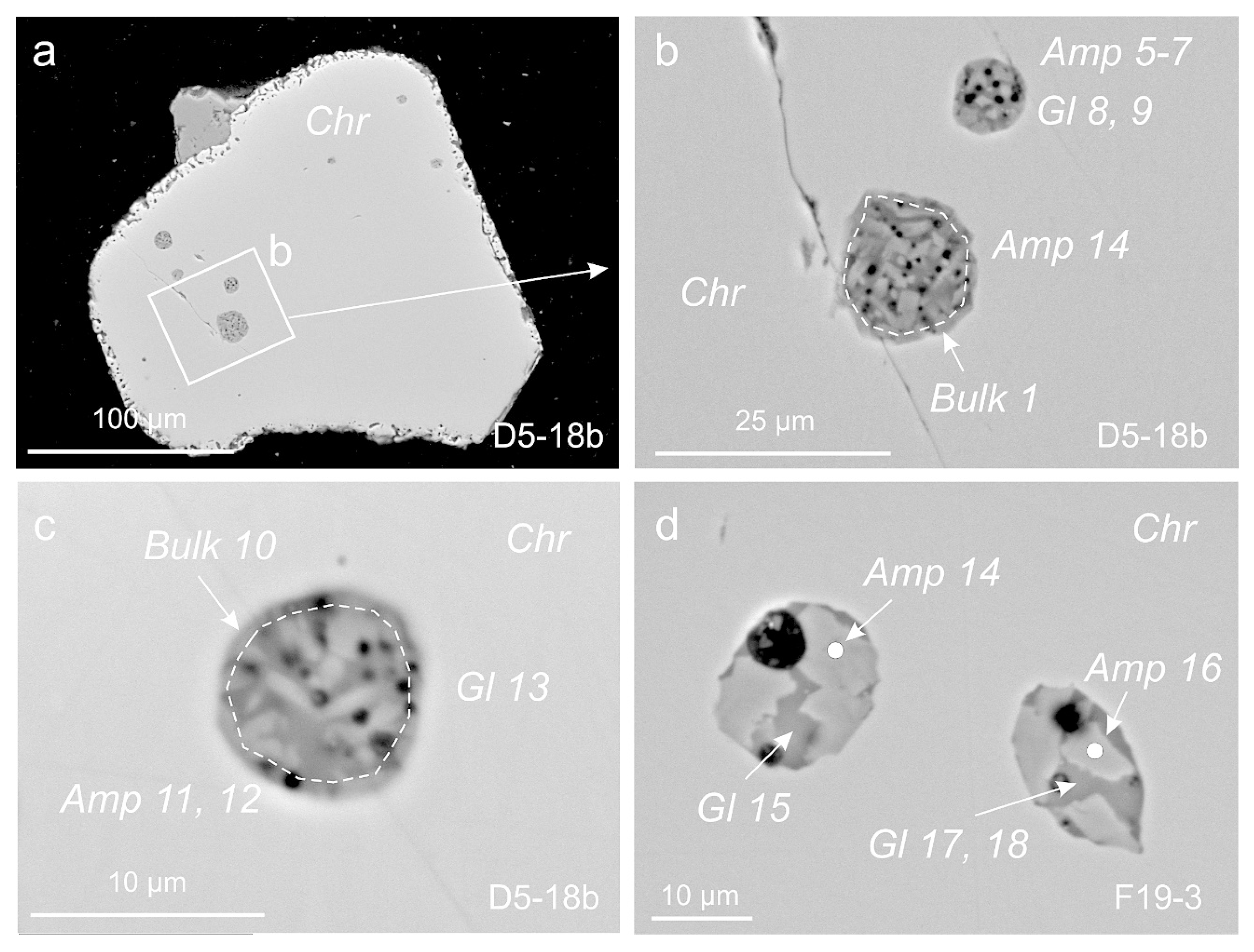
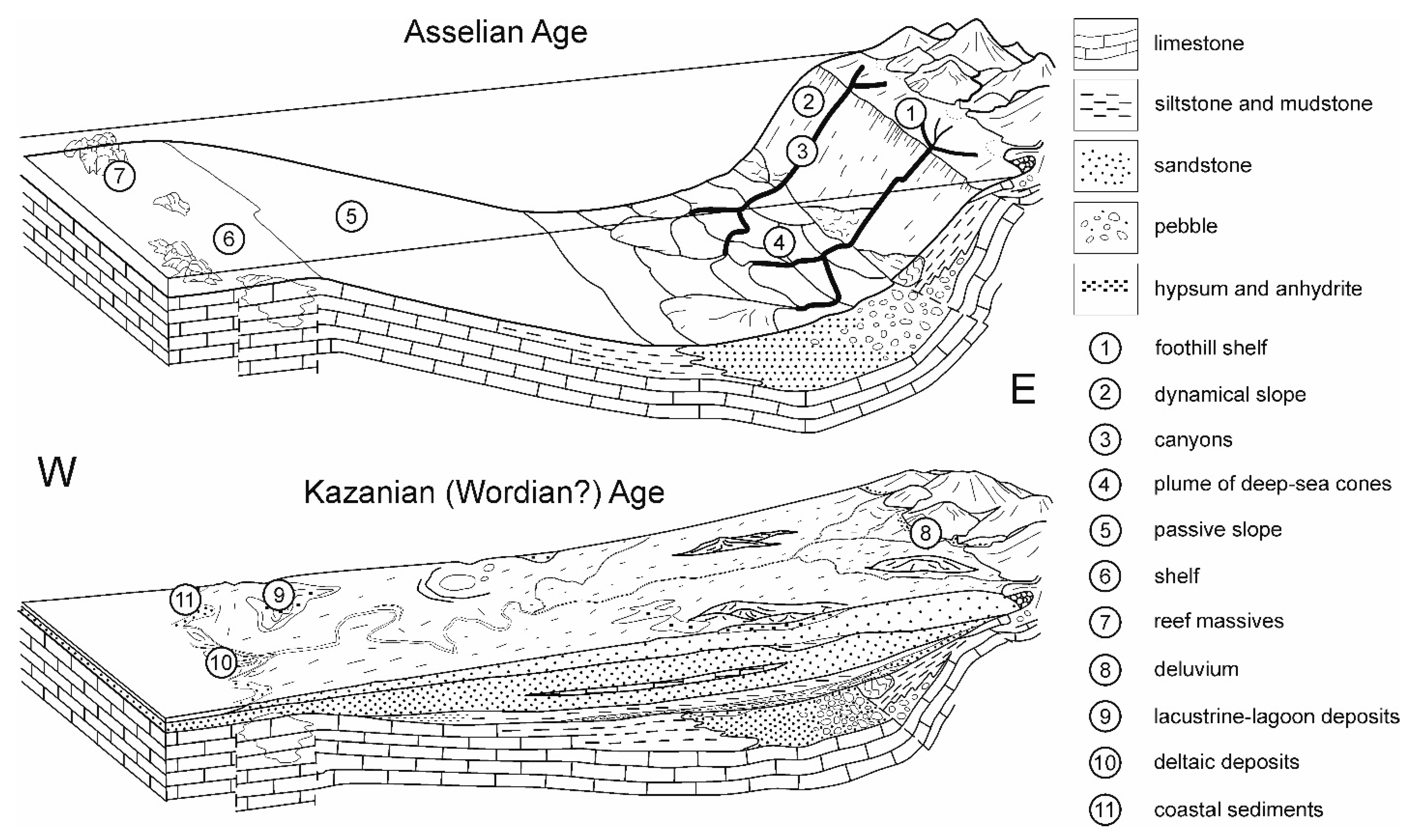
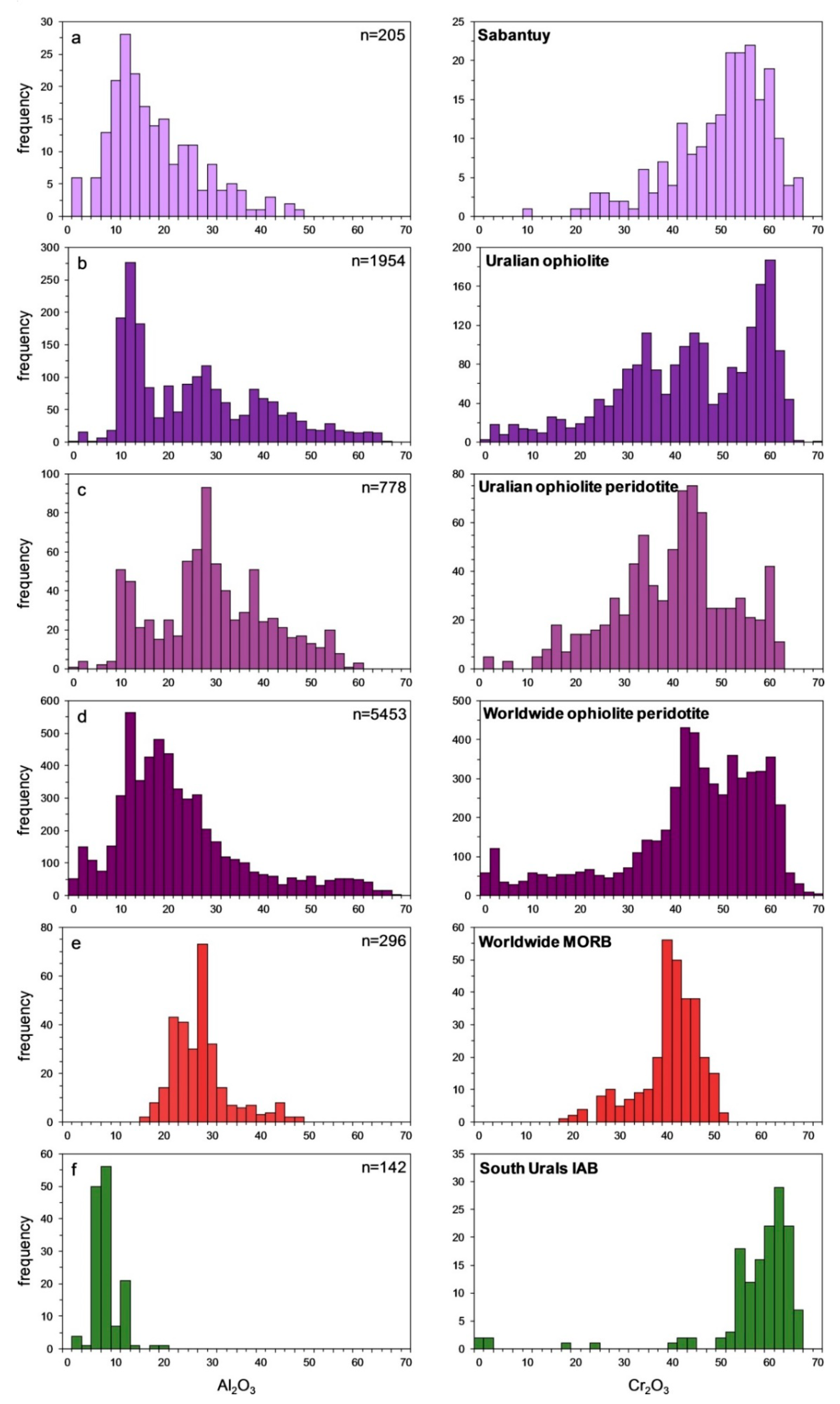
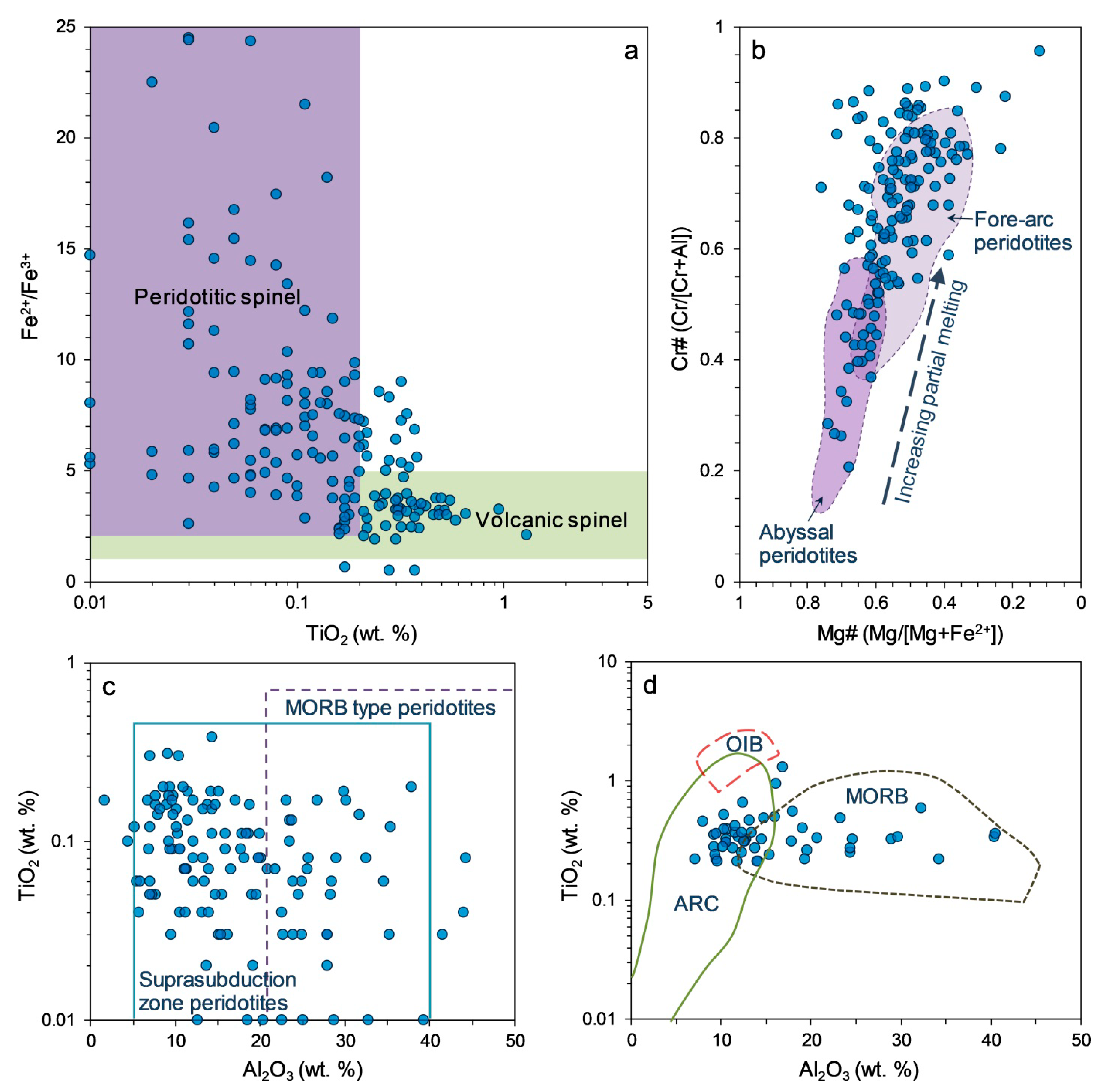
| # | Sample | SiO2 | TiO2 | Al2O3 | FeOt | Cr2O3 | MnO | MgO | CaO | Na2O | K2O | P2O5 | S | LOI | Total |
|---|---|---|---|---|---|---|---|---|---|---|---|---|---|---|---|
| 1 | D3-4 | 4.40 | 4.32 | 5.04 | 15.55 | 12.07 | 0.35 | 14.34 | 23.81 | 3.00 | 0.08 | 0.07 | 0.04 | 13.98 | 97.05 |
| 2 | D3-5 | 4.87 | 6.83 | 5.64 | 19.54 | 16.55 | 0.48 | 16.48 | 13.00 | 2.00 | 0.10 | 0.12 | 0.07 | 13.99 | 99.65 |
| 3 | D5-13-ai | 4.03 | 5.25 | 5.55 | 21.24 | 15.02 | 0.19 | 11.19 | 20.54 | 0.10 | 0.03 | 0.10 | 0.07 | 16.55 | 99.86 |
| 4 | D5-13-as | 4.09 | 4.73 | 5.03 | 21.60 | 14.07 | 0.18 | 12.86 | 23.51 | 0.10 | 0.03 | 0.09 | 0.06 | 11.75 | 98.10 |
| 5 | D5-14a | 24.60 | 0.65 | 4.10 | 4.48 | 1.60 | 0.19 | 10.30 | 28.69 | 0.47 | 0.17 | 0.07 | 0.02 | 24.36 | 99.70 |
| 6 | D5-14b | 20.91 | 0.89 | 3.99 | 5.32 | 2.68 | 0.19 | 10.72 | 28.77 | 0.53 | 0.12 | 0.07 | 0.01 | 24.49 | 98.69 |
| 7 | D5-14bx | 22.35 | 0.80 | 4.87 | 4.72 | 2.10 | 0.17 | 10.24 | 28.58 | 0.52 | 0.12 | 0.08 | 0.02 | 24.65 | 99.20 |
| 8 | D5-18a | 17.91 | 2.80 | 6.93 | 13.52 | 16.06 | 0.14 | 5.18 | 18.87 | 0.60 | 0.08 | 0.04 | 0.04 | 16.87 | 99.03 |
| 9 | D5-19 | 29.66 | 0.24 | 5.30 | 3.16 | 0.03 | 0.18 | 6.50 | 25.99 | 0.64 | 0.20 | 0.06 | 0.04 | 27.03 | 99.03 |
| 10 | F19-1 | 18.06 | 2.26 | 5.63 | 12.90 | 14.96 | 0.13 | 2.12 | 24.60 | 0.64 | 0.08 | 0.05 | 0.04 | 17.61 | 99.08 |
| 11 | F19-2 | 29.03 | 0.98 | 5.15 | 7.36 | 10.64 | 0.10 | 4.35 | 22.86 | 0.61 | 0.20 | 0.05 | 0.03 | 17.52 | 98.88 |
| 12 | F19-5 | 13.17 | 1.37 | 3.98 | 10.52 | 10.91 | 0.10 | 6.00 | 29.19 | 1.35 | 0.11 | 0.06 | 0.03 | 22.50 | 99.29 |
| 13 | F19-7 | 27.01 | 0.24 | 4.66 | 3.24 | 0.06 | 0.17 | 3.68 | 31.21 | 1.54 | 0.17 | 0.08 | 0.04 | 26.95 | 99.05 |
| # | TiO2 | Al2O3 | Cr2O3 | V2O3 | FeO | MnO | MgO | NiO | ZnO | CaO | Total |
|---|---|---|---|---|---|---|---|---|---|---|---|
| 1 | 0.09 | 17.68 | 50.42 | 0.22 | 19.81 | 0.22 | 10.54 | 0.07 | 0.16 | 0 | 99.21 |
| 2 | 0.04 | 5.76 | 65.06 | 0.04 | 17.09 | 0.05 | 12.55 | 0.08 | 0.12 | 0.01 | 100.79 |
| 3 | 0.17 | 30.2 | 37.85 | 0.24 | 17.68 | 0.05 | 13.79 | 0.15 | 0.15 | 0 | 100.28 |
| 4 | 0 | 47.33 | 18.22 | 0.11 | 17.07 | 0.07 | 16.27 | 0.29 | 0.21 | 0.02 | 99.58 |
| 5 | 0.1 | 23.48 | 43.49 | 0.3 | 19.86 | 0.1 | 12.79 | 0.11 | 0.1 | 0 | 100.33 |
| 6 | 0.09 | 10.53 | 60.89 | 0.08 | 15.7 | 0.04 | 12.72 | 0.08 | 0.12 | 0.01 | 100.25 |
| 7 | 0.07 | 13.97 | 53.94 | 0.21 | 20.91 | 0.06 | 10.19 | 0.07 | 0.21 | 0 | 99.63 |
| 8 | 0 | 5.1 | 61.65 | 0.34 | 24.3 | 0.27 | 5.6 | 0.01 | 0.29 | 0.06 | 97.56 |
| 9 | 0.06 | 7.03 | 64.19 | 0.11 | 13.33 | 0 | 14.57 | 0.18 | 0 | 0 | 99.47 |
| 10 | 0.09 | 6.87 | 65.31 | 0.13 | 14.03 | 0 | 13.66 | 0.07 | 0.09 | 0.02 | 100.25 |
| 11 | 0.11 | 10.35 | 58.43 | 0.25 | 23.04 | 0.23 | 7.85 | 0.04 | 0.31 | 0 | 100.61 |
| 12 | 0.17 | 0.1 | 20.21 | 0.14 | 72.08 | 0.44 | 1.63 | 0.41 | 0.15 | 0.07 | 95.33 |
| 13 | 0.01 | 39.32 | 27.99 | 0.12 | 15.7 | 0.06 | 15.94 | 0.2 | 0.23 | 0 | 99.57 |
| 14 | 0.03 | 15.16 | 55.68 | 0.19 | 14.11 | 0.1 | 13.14 | 0.1 | 0.14 | 0 | 98.65 |
| 15 | 0.05 | 15.47 | 55.86 | 0.22 | 14.44 | 0.02 | 12.98 | 0.12 | 0.05 | 0.05 | 99.21 |
| 16 | 0.06 | 12.07 | 57.41 | 0.23 | 18.92 | 0.19 | 9.96 | 0 | 0.06 | 0 | 98.9 |
| 17 | 0.32 | 28.95 | 37.21 | 0.14 | 17.18 | 0.11 | 15.89 | 0.16 | 0.19 | 0.01 | 100.17 |
| 18 | 0.46 | 8.01 | 55.97 | 0.09 | 23.55 | 0.26 | 9.89 | 0.04 | 0.22 | 0.04 | 98.49 |
| 19 | 0.38 | 14.29 | 52.65 | 0.2 | 22.55 | 0.2 | 10.1 | 0.09 | 0.01 | 0.04 | 100.47 |
| 20 | 0.08 | 32.51 | 33.24 | 0.18 | 19.54 | 0.16 | 13.92 | 0.09 | 0.14 | 0 | 99.86 |
| 21 | 0.52 | 10.33 | 51.44 | 0.17 | 28.41 | 0.19 | 7.73 | 0 | 0.24 | 0.01 | 99.03 |
| 22 | 0.01 | 28.7 | 40.17 | 0.09 | 15.85 | 0.09 | 14.97 | 0.15 | 0.06 | 0.02 | 100.09 |
| 23 | 0 | 32.95 | 36.41 | 0.16 | 14.59 | 0.08 | 15.06 | 0.1 | 0.07 | 0.03 | 99.42 |
| 24 | 0.28 | 0.08 | 9.93 | 0.09 | 81.61 | 0.33 | 1.83 | 0.81 | 0 | 0.02 | 95.01 |
| 25 | 0.07 | 21.78 | 47.22 | 0.25 | 19.6 | 0.25 | 10.36 | 0 | 0.29 | 0 | 99.82 |
| 26 | 0.05 | 19.02 | 52.57 | 0.11 | 14.87 | 0.03 | 13.06 | 0.05 | 0.18 | 0 | 99.94 |
| 27 | 0.14 | 7.89 | 61.06 | 0.11 | 20.08 | 0.24 | 9.77 | 0.05 | 0.06 | 0.01 | 99.4 |
| 28 | 0.16 | 7.72 | 59.33 | 0.1 | 18.66 | 0.06 | 13.03 | 0.05 | 0.02 | 0 | 99.13 |
| 29 | 0.32 | 14.51 | 51.03 | 0.14 | 22.53 | 0.16 | 9.78 | 0.03 | 0.1 | 0.01 | 98.6 |
| 30 | 0.07 | 16.53 | 51.88 | 0.21 | 22.78 | 0.46 | 7.74 | 0 | 0.34 | 0.02 | 100.01 |
| 31 | 0.06 | 5.39 | 64.37 | 0.09 | 19.52 | 0.09 | 9.98 | 0.06 | 0.12 | 0.01 | 99.68 |
| 32 | 0 | 29.51 | 40.59 | 0.11 | 12.82 | 0.07 | 16.13 | 0.13 | 0.05 | 0 | 99.41 |
| 33 | 0.01 | 32.82 | 35.93 | 0.2 | 16.65 | 0.07 | 13.77 | 0.11 | 0.25 | 0.01 | 99.81 |
| 34 | 0 | 7.03 | 63.05 | 0.09 | 19.29 | 0.17 | 9.25 | 0.09 | 0.14 | 0.01 | 99.11 |
| 35 | 0.08 | 12.16 | 55.95 | 0.14 | 20.09 | 0.25 | 10.37 | 0.1 | 0.1 | 0 | 99.24 |
| 36 | 0.24 | 15.42 | 41.83 | 0.17 | 31.63 | 0.2 | 8.46 | 0.11 | 0.31 | 0 | 98.37 |
| 37 | 0.03 | 41.57 | 24.55 | 0.11 | 15.38 | 0.12 | 17.68 | 0.28 | 0.09 | 0 | 99.81 |
| 38 | 0 | 18.01 | 51.79 | 0.29 | 19.13 | 0.16 | 11.1 | 0.07 | 0.19 | 0 | 100.74 |
| 39 | 0.07 | 11.37 | 59.78 | 0.12 | 15.2 | 0.06 | 12.11 | 0.07 | 0.04 | 0 | 98.82 |
| 40 | 0.06 | 28.39 | 39.4 | 0.14 | 16.93 | 0.12 | 14.52 | 0.15 | 0.06 | 0 | 99.77 |
| 41 | 0.42 | 11.59 | 51.66 | 0.2 | 26.58 | 0.17 | 8.71 | 0.04 | 0.08 | 0 | 99.45 |
| 42 | 0.06 | 5.89 | 61.15 | 0.05 | 28.19 | 0.3 | 4.14 | 0.05 | 0.01 | 0 | 99.84 |
| 43 | 0.12 | 5.13 | 63.36 | 0.09 | 22.09 | 0.17 | 8.87 | 0.04 | 0.07 | 0 | 99.94 |
| 44 | 0.05 | 7.32 | 61.43 | 0.1 | 21.16 | 0.1 | 9.42 | 0.03 | 0.11 | 0.01 | 99.72 |
| 45 | 0.34 | 40.43 | 25.71 | 0.15 | 14.08 | 0.07 | 18.04 | 0.27 | 0.03 | 0.01 | 99.21 |
| 46 | 0.05 | 7.02 | 65.48 | 0.19 | 17.14 | 0.1 | 10.23 | 0.04 | 0.11 | 0 | 100.36 |
| 47 | 0.18 | 9.27 | 54.1 | 0.17 | 25.77 | 0.15 | 9.02 | 0.02 | 0.09 | 0.02 | 98.77 |
| 48 | 0.4 | 19.07 | 47.14 | 0.15 | 20.47 | 0.13 | 12.42 | 0.15 | 0.24 | 0 | 100.17 |
| 49 | 0.2 | 37.86 | 29.22 | 0.15 | 14.29 | 0.1 | 16.13 | 0.24 | 0.22 | 0 | 98.41 |
| 50 | 0.18 | 7.65 | 60.01 | 0.08 | 21.96 | 0.18 | 10.17 | 0.05 | 0.04 | 0.01 | 100.32 |
| Sample | D5-13 | D5-18b | F19-3 | ||||||
|---|---|---|---|---|---|---|---|---|---|
| Analytical Points | 1 | 2 | 3 * | 4 | 5 | 6 | 7 * | 8 * | 9 * |
| SiO2 | 41.43 | 41.49 | 41.18 | 42.02 | 41.82 | 41.33 | 40.93 | 41.19 | 41 |
| Cr2O3 | 1.20 | 1.23 | 2.00 | 0.72 | 0.67 | 0.35 | 1.52 | 1.20 | 1.64 |
| FeO | 6.72 | 6.27 | 6.31 | 5.88 | 6.93 | 7.14 | 6.5 | 6.42 | 6.54 |
| MnO | 0.09 | 0.07 | n.d. | 0.08 | 0.08 | 0.09 | n.d. | n.d. | n.d. |
| MgO | 51.34 | 51.70 | 50.17 | 50.85 | 50.77 | 51.14 | 50.61 | 50.70 | 50.19 |
| CaO | n.d. | 0.02 | n.d. | n.d. | n.d. | n.d. | n.d. | n.d. | n.d. |
| NiO | 0.47 | 0.43 | 0.34 | 0.38 | 0.49 | 0.53 | 0.44 | 0.49 | 0.64 |
| Total | 101.26 | 101.21 | 100.00 | 99.94 | 100.77 | 100.59 | 100.00 | 100.00 | 100.00 |
| Mg/(Mg + Fe) | 0.93 | 0.94 | 0.94 | 0.94 | 0.93 | 0.93 | 0.93 | 0.93 | 0.93 |
| Cr# | 0.54 | 0.54 | 0.54 | 0.75 | 0.61 | 0.39 | 0.52 | 0.52 | 0.52 |
| Sample | D5-13 | F19-3 | D5-18b | |||||
|---|---|---|---|---|---|---|---|---|
| Analytical Points | 1 | 2 | 3 * | 4 * | 5 * | 6 * | 7 * | 8 * |
| SiO2 | 54.04 | 54.50 | 53.53 | 43.44 | 46.18 | 49.07 | 53.83 | 48.13 |
| TiO2 | 0.07 | 0.08 | 0.00 | 0.60 | 1.49 | 1.59 | 0.35 | 2.15 |
| Al2O3 | 1.03 | 0.86 | 1.37 | 13.85 | 12.06 | 9.77 | 1.74 | 9.62 |
| Cr2O3 | 1.05 | 2.05 | 1.75 | 3.21 | 1.03 | 2.88 | 1.83 | 2.88 |
| FeO | 2.24 | 1.93 | 1.90 | 3.29 | 4.80 | 3.47 | 2.34 | 3.52 |
| MnO | 0.06 | 0.05 | n.d. | n.d. | n.d. | n.d. | n.d. | n.d. |
| MgO | 17.41 | 16.80 | 16.67 | 18.75 | 11.37 | 19.07 | 16.90 | 18.61 |
| CaO | 24.35 | 23.79 | 24.78 | 13.11 | 23.08 | 12.38 | 23.01 | 12.61 |
| Na2O | 0.19 | 0.54 | 0.00 | 3.46 | n.d. | 1.76 | 0.00 | 2.30 |
| K2O | n.d. | n.d. | n.d. | 0.28 | n.d. | n.d. | n.d. | 0.18 |
| Total | 100.44 | 100.60 | 100.00 | 100.00 | 100.00 | 100.00 | 100.00 | 100.00 |
| Mg/(Mg + Fe) | 0.93 | 0.94 | 0.94 | 0.91 | 0.81 | 0.91 | 0.93 | 0.91 |
| Sample | D5-18b | F19-1 | ||||||
| Analytical Points | 9* | 10 * | 11 | 12 | 13 | 14 | 15 | 16 |
| SiO2 | 47.37 | 68.79 | 49.74 | 49.40 | 49.43 | 49.38 | 49.17 | 52.13 |
| TiO2 | n.d. | n.d. | 0.28 | 0.34 | 0.23 | 0.36 | 0.26 | 0.04 |
| Al2O3 | 32.93 | 18.66 | 7.65 | 7.40 | 7.47 | 7.53 | 7.61 | 5.82 |
| Cr2O3 | 0.59 | 0.80 | 1.64 | 1.51 | 1.45 | 1.57 | 1.49 | 2.15 |
| FeO | 0.50 | 0.21 | 4.45 | 4.75 | 4.79 | 4.72 | 4.93 | 2.20 |
| MnO | n.d. | n.d. | n.d. | 0.05 | 0.07 | 0.05 | 0.06 | 0.09 |
| MgO | n.d. | n.d. | 19.63 | 19.32 | 19.47 | 19.39 | 19.87 | 21.81 |
| CaO | 16.89 | 0.89 | 12.92 | 12.78 | 12.93 | 12.84 | 12.92 | 12.36 |
| Na2O | 1.73 | 10.65 | 1.20 | 1.18 | 1.14 | 1.16 | 1.08 | 1.58 |
| K2O | n.d. | n.d. | 0.44 | 0.53 | 0.51 | 0.49 | 0.60 | 0.05 |
| Total | 100.00 | 100 | 97.95 | 97.26 | 97.49 | 97.49 | 97.99 | 98.23 |
| Mg/(Mg + Fe) | 0.89 | 0.88 | 0.88 | 0.88 | 0.88 | 0.95 | ||
| Sample | D5-13 | D5-18 | F19-1 | F19-3 | |||||
|---|---|---|---|---|---|---|---|---|---|
| Analytical Points | 1 * | 2 | 3 | 4 * | 5 * | 6 | 7 | 8 | 9 |
| SiO2 | 56.22 | 58.12 | 58.41 | 57.19 | 56.98 | 57.06 | 57.32 | 56.31 | 57.11 |
| TiO2 | n.d. | 0.04 | n.d. | n.d. | n.d. | n.d. | n.d. | n.d. | n.d. |
| Al2O3 | 1.60 | 0.36 | 0.35 | 1.25 | 1.19 | 1.31 | 1.26 | 1.80 | 1.77 |
| Cr2O3 | 1.78 | 0.97 | 1.07 | 1.39 | 0.92 | 1.27 | 1.19 | 1.06 | 0.93 |
| FeO | 5.94 | 4.56 | 4.42 | 4.49 | 5.66 | 4.45 | 4.33 | 5.72 | 5.80 |
| MnO | n.d. | 0.09 | 0.09 | n.d. | 0.23 | 0.16 | 0.15 | 0.11 | 0.16 |
| MgO | 34.00 | 36.52 | 36.15 | 35.17 | 34.83 | 35.06 | 35.18 | 34.40 | 34.32 |
| CaO | 0.45 | 0.41 | 0.47 | 0.52 | 0.19 | 0.97 | 0.94 | 0.81 | 0.82 |
| Total | 100.00 | 101.17 | 101.02 | 100.00 | 100.00 | 100.36 | 100.48 | 100.32 | 101.00 |
| Mg/(Mg + Fe) | 0.91 | 0.94 | 0.94 | 0.93 | 0.92 | 0.93 | 0.94 | 0.92 | 0.91 |
| Sample | D5-18b | D5-18b | |||||||
|---|---|---|---|---|---|---|---|---|---|
| Analytical Points | 1 | 2 | 3 | 4 | 5 | 6 | 7 | 8 | 9 |
| SiO2 | 46.7 | 48.1 | 48.4 | 47.1 | 42.1 | 44.4 | 45.1 | 49.5 | 43.9 |
| TiO2 | 1.3 | 1.7 | 1.5 | 0.9 | 1.3 | 1.4 | 1.4 | 1.3 | 1.0 |
| Al2O3 | 17.6 | 13.9 | 15.0 | 18.8 | 15.4 | 17.0 | 16.9 | 19.4 | 20.9 |
| Cr2O3 | 4.9 | 1.8 | 1.6 | 7.7 | 8.1 | 5.0 | 4.7 | 5.2 | 8.2 |
| FeO | 8.6 | 7.4 | 8.0 | 8.3 | 8.7 | 8.5 | 8.5 | 7.2 | 8.1 |
| MnO | n.d. | n.d. | n.d. | n.d. | n.d. | n.d. | 0.3 | 0.0 | 0.0 |
| MgO | 8.1 | 13.2 | 11.1 | 5.2 | 11.7 | 10.1 | 10.5 | 4.7 | 6.7 |
| CaO | 10.5 | 13.0 | 13.2 | 8.3 | 11.8 | 11.8 | 10.9 | 9.0 | 8.4 |
| Na2O | 2.2 | 1.0 | 1.1 | 3.7 | 1.0 | 1.8 | 1.3 | 3.3 | 2.7 |
| K2O | n.d. | n.d. | n.d. | n.d. | n.d. | n.d. | n.d. | 0.2 | 0.2 |
| Total | 100.0 | 100.0 | 100.0 | 100.0 | 100.0 | 100.0 | 100.0 | 100.0 | 100.0 |
| Mg/(Mg + Fe) | 0.6 | 0.8 | 0.7 | 0.5 | 0.7 | 0.7 | 0.7 | 0.5 | 0.6 |
| Sample | D5-18b | F19-3 | |||||||
| Analytical Points | 10 | 11 | 12 | 13 | 14 | 15 | 16 | 17 | 18 |
| SiO2 | 51.3 | 48.9 | 50.4 | 53.1 | 46.1 | 55.4 | 48.0 | 54.7 | 56.4 |
| TiO2 | 1.5 | 1.5 | 1.5 | 1.1 | 2.1 | 1.2 | 1.9 | 1.7 | 1.0 |
| Al2O3 | 18.4 | 16.1 | 17.4 | 20.1 | 11.9 | 22.5 | 9.7 | 21.3 | 21.9 |
| Cr2O3 | 1.7 | 1.5 | 1.2 | 1.9 | 0.8 | 0.9 | 0.9 | 1.3 | 1.0 |
| FeO | 7.4 | 7.6 | 7.6 | 6.1 | 7.8 | 6.1 | 6.9 | 6.9 | 6.5 |
| MnO | n.d. | n.d. | n.d. | n.d. | 0.2 | n.d. | n.d. | n.d. | n.d. |
| MgO | 5.6 | 9.8 | 7.5 | 3.9 | 14.5 | 1.2 | 18.3 | 0.5 | 0.5 |
| CaO | 11.7 | 12.8 | 12.7 | 10.2 | 16.5 | 6.9 | 14.4 | 7.9 | 8.7 |
| Na2O | 2.2 | 1.2 | 1.5 | 3.0 | 0.0 | 5.9 | 0.0 | 5.2 | 4.7 |
| K2O | 0.3 | 0.2 | 0.2 | 0.3 | n.d. | n.d. | n.d. | n.d. | n.d. |
| Total | 100.0 | 100.0 | 100.0 | 100.0 | 100.0 | 100.0 | 100.0 | 100.0 | 100.0 |
| Mg/(Mg + Fe) | 0.6 | 0.7 | 0.6 | 0.5 | 0.8 | 0.3 | 0.8 | 0.1 | 0.1 |
Publisher’s Note: MDPI stays neutral with regard to jurisdictional claims in published maps and institutional affiliations. |
© 2021 by the authors. Licensee MDPI, Basel, Switzerland. This article is an open access article distributed under the terms and conditions of the Creative Commons Attribution (CC BY) license (https://creativecommons.org/licenses/by/4.0/).
Share and Cite
Rakhimov, I.R.; Pushkarev, E.V.; Gottman, I.A. Chromite Paleoplacer in the Permian Sediments at the East Edge of the East European Platform: Composition and Potential Sources. Minerals 2021, 11, 691. https://doi.org/10.3390/min11070691
Rakhimov IR, Pushkarev EV, Gottman IA. Chromite Paleoplacer in the Permian Sediments at the East Edge of the East European Platform: Composition and Potential Sources. Minerals. 2021; 11(7):691. https://doi.org/10.3390/min11070691
Chicago/Turabian StyleRakhimov, Ildar R., Evgenii V. Pushkarev, and Irina A. Gottman. 2021. "Chromite Paleoplacer in the Permian Sediments at the East Edge of the East European Platform: Composition and Potential Sources" Minerals 11, no. 7: 691. https://doi.org/10.3390/min11070691
APA StyleRakhimov, I. R., Pushkarev, E. V., & Gottman, I. A. (2021). Chromite Paleoplacer in the Permian Sediments at the East Edge of the East European Platform: Composition and Potential Sources. Minerals, 11(7), 691. https://doi.org/10.3390/min11070691






